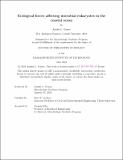Ecological forces affecting microbial eukaryotes in the coastal ocean
Author(s)
Gomez, Annika L.
DownloadThesis PDF (19.50Mb)
Advisor
Cordero, Otto X.
Terms of use
Metadata
Show full item recordAbstract
Marine microbial eukaryotes (protists) play a central role in the global biogeochemical cycles. Protist communities comprise carbon-fixing eukaryotic phytoplankton, which comprise the base of the marine food web, heterotrophic protists, which are predators of other microbes, and mixotrophs, which engage in a combination of these nutritional modes. The total abundance of a protistan population at any given time relies upon a combination of growth and death rates, which are impacted by nutrient availability (bottom-up control) and predation (top-down control). In this thesis, I investigate the effect of specific top-down and bottom-up forces at fine scales of time, location, and taxonomy, uncovering mechanisms by which nutrient limitation and viral infection affect marine protistan communities. In the first study, I leverage the 93-day Nahant Time Series to examine the dynamics and ecology of viruses infecting marine protists, the majority of which have only been identified by culture-independent means. This study focuses on Nucleocytoviricota, a diverse group of eukaryote-infecting dsDNA viruses with known potential to influence host metabolism and nutrient cycling. I developed a novel metagenomic sequence analysis pipeline which resolves cohesive populations of Nucleocytoviricota based on daily dynamics. Virus populations exhibit rapid and extensive fluctuations throughout the time series, mirroring the dynamics of their hosts. Diversity and structure of populations is indicative of viral ecology, with large networks of overlapping viruses and hosts suggestive of broad host range of some viruses while sharp population boundaries suggest viruses with narrow host ranges. In the second study, I investigate the role of bottom-up control, describing the effects of nutrient limitation on phytoplankton sinking velocity. We measure single-cell buoyant mass using a suspended microchannel resonator (SMR). Buoyant mass directly relates to sinking velocity through Stoke’s law. We show that sinking velocity can be modulated by nutrient limitations via the accumulation of carbohydrates which increase cell density. These results demonstrate that in addition to cell growth, nutrient limitation can also affect vertical stratification within phytoplankton populations. The combined conclusions of these chapters demonstrate novel mechanisms by which top-down and bottom-up forces shape marine protistan communities.
Date issued
2024-05Department
Massachusetts Institute of Technology. Department of Biology; Massachusetts Institute of Technology. Microbiology Graduate ProgramPublisher
Massachusetts Institute of Technology